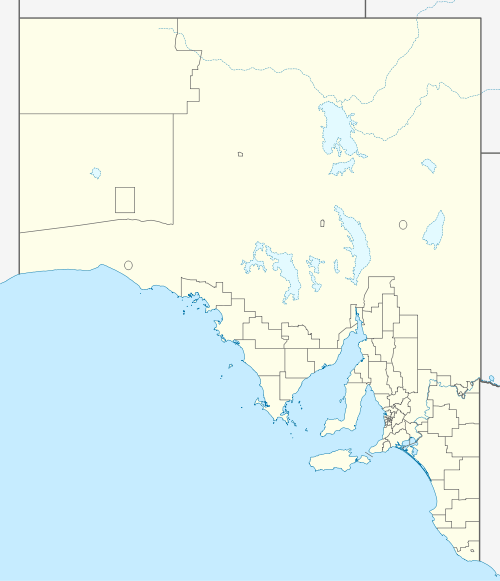Wedge Island (South Australia)
Wedge Island is an island in the Australian state of South Australia located within the island group known as the Gambier Islands near the entrance to Spencer Gulf. It is the largest of the Gambier Islands, covers an area of about 10 square kilometres (3.9 sq mi) and is partly privately owned.
 View from Royston Head | |
 Wedge Island | |
| Geography | |
|---|---|
| Location | Spencer Gulf |
| Coordinates | 35.1554°S 136.4649°E |
| Administration | |
Australia | |
Description
There is a lighthouse at the south-eastern end, and highest point, of the island. There is an airstrip on the island as well as a jetty. The island is not permanently inhabited, but has buildings used for holiday accommodation and as a base for local and offshore recreational fishing. It is also a dive site.
History
Wedge Island was named in 1802 by Matthew Flinders. It was originally settled in the mid-19th century as a farm for breeding horses for the British Indian Army, with various agricultural activities such sheep and cattle grazing and wheat cropping continuing for the next 130 years.
In 1929, Andrew Golley left the island after living there for forty years. He had originally moved there with his parents. His interest in the island was transferred to H. R. Littley who moved there with his wife, son, daughter and son-in-law.[1]
During World War II, Wedge Island was used as a radar station by the Royal Australian Air Force (RAAF). A bunker was constructed near the lighthouse and was occupied by about 40 RAAF personnel for several years.[2]
Flora and fauna
Fauna
An account of the wildlife on Wedge Island from 1928 reads:
"The penguins were busy with their half-grown youngsters, and after dark the night echoed to their weird and ghostlike cries. Quail were plentiful among the grass paddocks and flew up almost from beneath our feet, while high above our heads a pair of wedge-tailed eagles wheeled and circled then planed slowly down to alight upon a lone pinnacle of the rocky western coast."[3]
Further detail appears in a 1929 account:
"Seabirds abound. Penguins and hair seals (Australian sealions) are on Wedge Island also. About September, mutton birds arrive in huge flocks. They breed extensively on Gambier Island, which is close to Wedge."[4]
Little penguins are known to have lived on the island from at least 1924,[5] and were known to the Gambier Islands since at least 1869.[6][7] A 1986 account of North Island described a population of "thousands" of muttonbirds and penguins there.[8] Little penguin breeding sites were noted in a 1996 survey of South Australia's offshore islands.[9]
A 1928 account of the Haycocks (off Wedge Island) describes a party from the Avocet filming the "large number" of seals there.[10]
In 2004 there were estimated to be fewer than 100 little penguins in the colony.[11]
Introduced species
The island has had many species introduced to it since European colonisation. It has been used to breed horses for re-mounting of the British armed forces in India. It has also been ravaged by goats. Turkeys were plentiful there in the 1920s.[12]
Southern hairy-nosed Wombats were introduced in 1971 to boost tourism appeal and there are now about 300 living on the island.[13] The endangered Brush-tailed Bettong has been introduced to the island for the purpose of conserving the species.[14]
Wedge Island Important Bird Area
Wedge island has been identified as an Important Bird Area by BirdLife International, an international non-governmental organization, because it supports over 1% of the world population, with up to about 16,000 breeding pairs, of white-faced storm-petrels.[15]
References
- "SOUTH AUSTRALIAN ROBINSON CRUSOE". Observer (Adelaide, SA : 1905 - 1931). 22 June 1929. p. 62. Retrieved 21 June 2020.
- A.C., Robinson; Canty, P.; Mooney, T.; Rudduck, P. (1996). South Australia's offshore islands (PDF). Canberra: Australian Heritage Commission. p. 126. ISBN 0-644-35011-3. Archived (PDF) from the original on 5 July 2015. Retrieved 3 January 2014.
- "ISLANDS OF REMEMBRANCE. In Flinders' Track. Cruise of the Avocet." The Register, South Australia (1928-01-21). Retrieved 2014-02-27.
- "SOUTH AUSTRALIAN ROBINSON CRUSOE". Observer (Adelaide, SA : 1905 - 1931). 22 June 1929. p. 62. Retrieved 21 June 2020.
- "Romance of South Australian Islands. Outposts of the State. Historical Links and Gems of Nature." The Mail, South Australia (14 June 1924). Retrieved 2014-03-14.
- "SPENCER'S GULF, SOUTH AUSTRALIA". Illustrated Adelaide Post (SA : 1867 - 1874). 16 July 1869. p. 13. Retrieved 18 June 2020.
- "A FIVE HUNDRED MILE CRUISE". Saturday Journal (Adelaide, SA : 1923 - 1929). 20 February 1926. p. 4. Retrieved 21 June 2020.
- Scarce, Graham (1986). A Cruising Guide to Historic Gulf Ports - Volume 3 - Spencer Gulf. South Australia: Kingsley Publications. p. 12. ISBN 0-9589703-4-3.
- Robinson, Tony; Canty, Peter; Mooney, Trish; Rudduck, Penny (1996). South Australia's Offshore Islands (PDF). South Australia: Resource Management Branch, Department of Environment and Natural Resources, South Australia. ISBN 0 644 35011 3.
- "ISLANDS OF REMEMBRANCE - In Flinders's Track. Cruise of the Avocet. - The Register (Adelaide, SA : 1901 - 1929) - 21 Jan 1928". Trove. Retrieved 12 July 2020.
- Wiebkin, A. S. (2011) Conservation management priorities for little penguin populations in Gulf St Vincent. Report to Adelaide and Mount Lofty Ranges Natural Resources Management Board. South Australian Research and Development Institute (Aquatic Sciences) Archived 22 February 2014 at the Wayback Machine, Adelaide. SARDI Publication No. F2011/000188-1. SARDI Research Report Series No.588. 97pp.
- "SOUTH AUSTRALIAN ROBINSON CRUSOE". Observer (Adelaide, SA : 1905 - 1931). 22 June 1929. p. 62. Retrieved 21 June 2020.
- Klein, Alice. "Noah's ark island is saving vulnerable species in Australia". New Scientist. Archived from the original on 25 October 2016. Retrieved 25 October 2016.
- Kennedy, Michael. (1992). Australasian Marsupials and Monotremes: An Action Plan for Their Conservation. IUCN. ISBN 978-2-8317-0052-6. p.82.
- "IBA: Wedge Island". Birdata. Birds Australia. Archived from the original on 6 July 2011. Retrieved 22 November 2011.